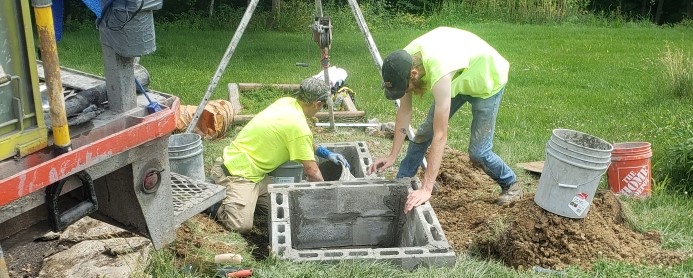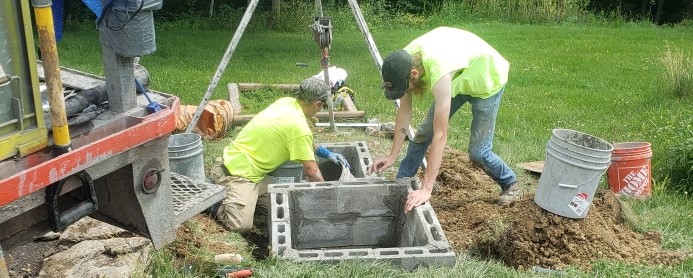If you have been wondering whether a concrete septic tank can be repaired, you’ll be glad to know that the answer is yes! Concrete septic tanks are a popular choice for homeowners due to their durability and longevity. However, over time, even the toughest of tanks can develop cracks, leaks, or other issues. Thankfully, there are effective repair options available that can restore the functionality of your concrete septic tank, saving you the hassle and expense of a complete replacement. In this article, we will explore the various methods and considerations involved in repairing a concrete septic tank, helping you make an informed decision for your septic system. So, let’s dive into the world of concrete septic tank repairs and learn how to maintain the health of your septic system.
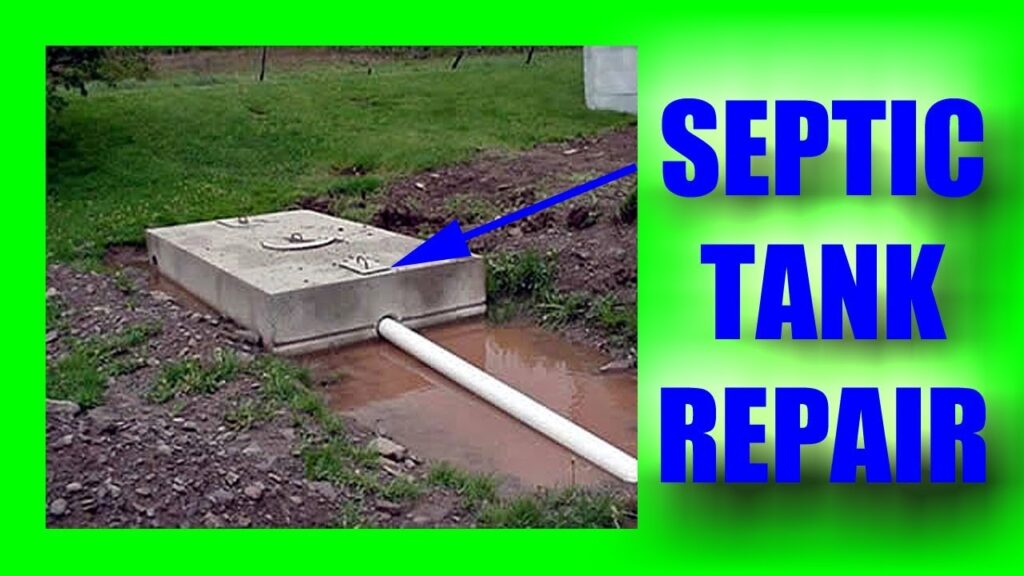
Understanding Septic Tanks
What is a septic tank?
A septic tank is an underground wastewater treatment structure commonly used in areas that are not connected to a centralized sewage system. It provides a safe and efficient way to treat and dispose of household wastewater.
Types of septic tanks
There are various types of septic tanks available, including concrete septic tanks, plastic septic tanks, and fiberglass septic tanks. Each type has its own advantages and disadvantages, but concrete septic tanks are the most commonly used due to their durability and longevity.
How does a concrete septic tank work?
A concrete septic tank works by separating solid waste from wastewater using a series of compartments. When wastewater enters the tank, the solids settle to the bottom and form sludge, while the liquid portion, known as effluent, floats to the top. Baffles within the tank prevent the sludge and scum from exiting the tank and entering the drain field. The effluent then flows out of the tank and into the drain field, where it is dispersed into the surrounding soil for further treatment and filtration.
Identifying Common Problems with Concrete Septic Tanks
Cracks or leaks
One of the most common problems with concrete septic tanks is the development of cracks or leaks. These can be caused by a variety of factors, including shifting soil, tree root invasion, or poor installation. Cracks or leaks in the tank can lead to wastewater leakage, which can contaminate groundwater and pose a threat to human health and the environment.
Baffle or tee problems
Another common issue with concrete septic tanks is problems with the baffles or tees. Baffles are placed inside the tank to regulate the flow of wastewater and prevent the accumulation of scum and sludge. If the baffles become damaged or dislodged, it can disrupt the proper functioning of the septic system and lead to issues such as clogged pipes or sewer backups.
Drain field issues
Problems with the drain field can also arise with concrete septic tanks. The drain field is responsible for further treating and filtering the effluent before it is absorbed into the soil. If the drain field becomes saturated or clogged, it can cause effluent to pool on the surface or back up into the tank, resulting in system failure and the need for repairs.
Overfilling and overflowing
Lastly, overfilling and overflowing can occur when a concrete septic tank is not properly maintained or when there is a sudden increase in water usage. Over time, the accumulation of solid waste can fill up the tank, reducing its capacity and causing wastewater to back up into the plumbing system. This not only poses a health risk but can also lead to costly repairs or the need for tank replacement.
Dangers of Damaged Concrete Septic Tanks
Health hazards
Damaged concrete septic tanks can pose significant health hazards. Wastewater leaking from cracks or leaks in the tank can contain harmful pathogens and pollutants that can contaminate groundwater and nearby water sources. This contaminated water can then be ingested by humans or animals, leading to a range of illnesses, including gastrointestinal infections, hepatitis, and other waterborne diseases.
Environmental risks
In addition to the health hazards, damaged concrete septic tanks also pose serious environmental risks. Wastewater leakage can pollute surface water bodies, such as lakes and rivers, and harm aquatic plants and animals. When groundwater becomes contaminated, it can affect the quality and availability of drinking water for nearby communities. Furthermore, the excessive nutrients present in untreated wastewater can contribute to algal blooms and water degradation.
Property damage
Damaged septic tanks can cause property damage as well. Wastewater backups can result in sewage overflow, which can damage floors, walls, and belongings in the affected area. Additionally, the leaking wastewater can saturate the soil surrounding the tank, leading to sinkholes, foul odors, and the disruption of landscape features. These damages can be costly to repair and can greatly diminish the value and aesthetics of the property.
Can a Concrete Septic Tank Be Repaired?
General possibility of repair
In many cases, a damaged concrete septic tank can be repaired rather than replaced. The feasibility of repair depends on the extent and nature of the damage, as well as the age and overall condition of the tank. Minor cracks or leaks can often be patched up, and problems with baffles or tees can usually be fixed. However, if the tank is severely corroded or structurally compromised, replacement may be the only viable option.
Factors affecting the feasibility of repair
Several factors can affect the feasibility of repairing a concrete septic tank. The first factor is the size and location of the damage. Small, localized cracks or leaks are generally easier to repair than larger, more extensive damage. Additionally, the accessibility of the tank plays a role. If the tank is buried deep underground or obstructed by other structures, it may be more challenging to perform repairs.
The age and overall condition of the tank are also important considerations. Older tanks that have undergone significant wear and tear may not be suitable for repair and would benefit more from replacement. It is essential to consult with a professional septic tank technician to accurately assess the condition of the tank and determine the best course of action.
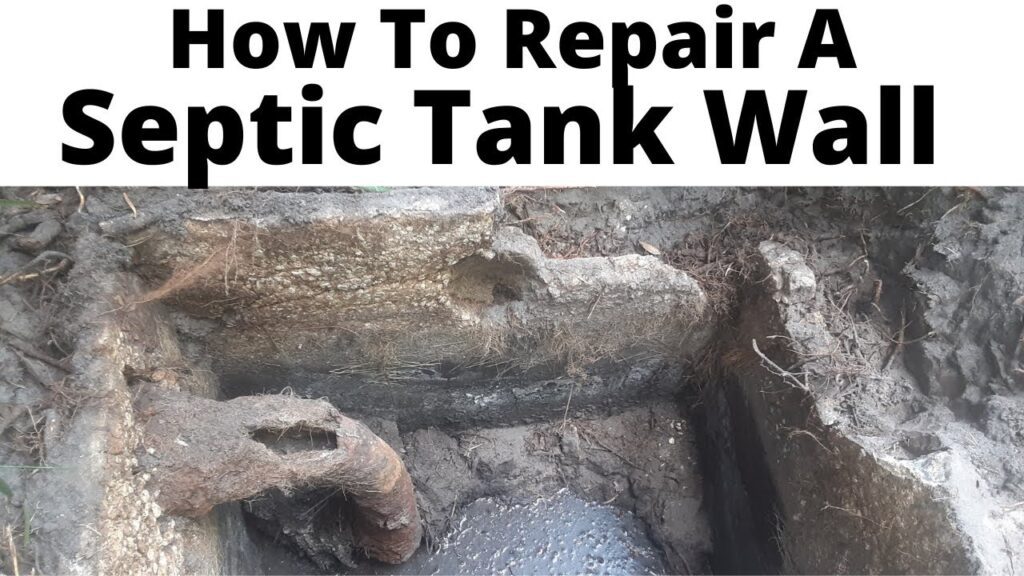
Inspection and Diagnosis of Concrete Septic Tank Problems
Professional inspection
When faced with concrete septic tank issues, it is advisable to seek the expertise of a professional septic tank technician. These professionals are trained to conduct thorough inspections and diagnose any problems with the tank. They have the knowledge and experience to identify cracks, leaks, baffle or tee issues, drain field problems, and signs of overfilling or overflowing. Through a comprehensive inspection, they can provide a detailed report outlining the scope of the damage and recommend the necessary repairs or replacement.
Self-inspection tips
While a professional inspection is crucial, there are some basic self-inspection tips that homeowners can follow to assess the condition of their concrete septic tank. Start by visually inspecting the tank for any visible signs of damage, such as cracks, leaks, or standing water around the tank. Additionally, pay attention to any unusual odors, slow drainage, or gurgling sounds coming from the plumbing system, as these can be indicators of septic tank issues. Monitoring the grass or vegetation growth around the tank can also provide insights into the health of the drain field.
Understanding the inspection report
Once a professional inspection is conducted, the septic tank technician will provide an inspection report. This report will outline the findings of the inspection, including any identified problems and the recommended course of action. It is essential to thoroughly understand the report and ask the technician any questions or seek clarification if needed. The inspection report serves as a valuable resource in determining whether a repair is possible or if a replacement is necessary.
Deciding if a repair is possible
Based on the inspection report and the advice of a professional septic tank technician, you can make an informed decision on whether to proceed with a repair or opt for a replacement. Consider the cost of repairs, the expected lifespan of the repaired tank, and the potential for future issues. If the repair is deemed feasible and cost-effective, it may be the best choice. However, if the tank is in poor condition and the repairs are temporary solutions, investing in a new septic tank may be a more sensible long-term investment.
Techniques for Concrete Septic Tank Repairs
Repairing cracks and leaks
Cracks and leaks in a concrete septic tank can be repaired using various techniques. Epoxy or polyurethane sealants can be applied to small cracks to plug the openings and prevent further leakage. Larger cracks may require the use of concrete patching materials or cement-based sealants. The damaged area must be thoroughly cleaned and prepped before applying the repair compound. It is important to follow the manufacturer’s instructions and ensure a proper cure for the repair to be effective.
Baffle or tee repair
Repairing damaged baffles or tees in a concrete septic tank typically involves removing the damaged component and replacing it with a new one. This repair should be carried out by a professional septic tank technician, as it requires expertise and specialized tools. The technician will carefully assess the problem and ensure that the replacement component is correctly installed to restore the proper functioning of the septic system.
Drain field remediation
In cases where the drain field is experiencing issues, such as saturation or clogging, several remediation techniques can be employed. One method is to perform a drain field rejuvenation, which involves introducing specialized bacteria or enzymes to help break down organic matter and restore the drainage capacity of the soil. Alternatively, sections of the drain field may need to be excavated and replaced to resolve the problem. This is a complex and labor-intensive repair that should be done by a professional.
Coping with overflow issues
If a concrete septic tank is consistently experiencing overfilling and overflowing, measures can be taken to mitigate the problem. Additional holding tanks or pump systems can be installed to increase the capacity of the system and prevent backups. Float switches can be installed to provide an alert when the tank reaches a certain level, allowing homeowners to take action before an overflow occurs. These solutions should be implemented by professionals to ensure their effectiveness and compliance with local regulations.
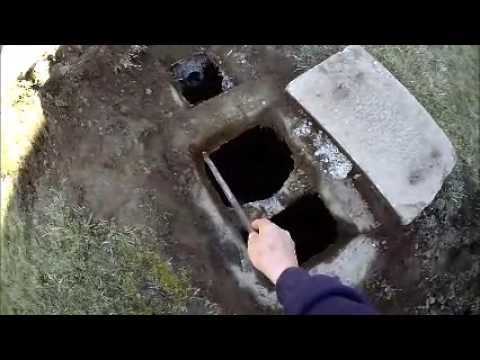
Professional Help for Concrete Septic Tank Repair
Hiring a professional septic tank technician
When it comes to repairing a concrete septic tank, it is highly recommended to hire a professional septic tank technician. These individuals have the necessary expertise, knowledge, and tools to accurately diagnose and repair septic tank issues. They are familiar with local regulations and can ensure that the repair work is performed in compliance with industry standards. Hiring a professional not only guarantees a quality repair but also reduces the risk of further damage or complications.
Cost of professional repair services
The cost of professional repair services for a concrete septic tank can vary depending on several factors, including the extent of the damage, the location of the tank, and the level of expertise required. Minor repairs, such as sealing small cracks, may be relatively inexpensive, while more extensive repairs or drain field remediation can be more costly. It is advisable to obtain multiple quotes from reputable septic tank technicians to compare prices and services before making a decision.
Finding reliable service providers
Finding reliable service providers for concrete septic tank repair can be done through several avenues. Start by asking for recommendations from friends, family, or neighbors who have had their septic tanks repaired in the past. Online directories and customer reviews can also provide insights into the reliability and quality of different service providers. Additionally, contacting local health departments or septic system contractors’ associations can provide information on licensed professionals in the area.
Do-it-yourself (DIY) concrete septic tank repair
When DIY repair is advisable
While hiring a professional is usually the recommended course of action for concrete septic tank repair, there are some instances where a DIY repair may be feasible. Simple repairs, such as sealing small cracks, can be tackled by homeowners with basic handyman skills. However, it is important to note that DIY repairs should only be attempted if the damage is minimal and poses no significant risk. If in doubt, it is always best to consult with a professional to ensure a safe and effective repair.
Tools and materials needed
For DIY concrete septic tank repairs, several tools and materials may be required, depending on the nature of the repair. Common tools include a putty knife, trowel, wire brush, and safety equipment such as gloves and goggles. The repair materials needed can vary but may include epoxy or polyurethane sealants, concrete patching compounds, and cement-based sealants. It is crucial to carefully follow the instructions provided with the materials and take all necessary safety precautions.
Step-by-step guide to DIY repair
-
Begin by cleaning and prepping the damaged area. Use a wire brush to remove any loose debris or contaminants from the crack or leak.
-
If the crack is small, apply a layer of epoxy or polyurethane sealant over the damaged area, ensuring that it covers the entire crack and extends slightly beyond. Smooth out the surface using a putty knife or trowel.
-
For larger cracks, mix the concrete patching compound according to the manufacturer’s instructions until it reaches a workable consistency.
-
Apply the concrete patching compound to the crack, pressing it firmly into place and ensuring that it fully fills the void. Use a trowel to smooth out the surface and blend it with the surrounding concrete.
-
Allow the repaired area to cure as per the instructions provided with the repair materials. This typically involves keeping the area moist and protected from external elements for a specified period.
-
Once the repair has fully cured, carefully inspect the area to ensure that the crack or leak has been effectively sealed.
Safety measures during DIY repair
When undertaking a DIY concrete septic tank repair, it is essential to prioritize safety. Ensure that you are wearing appropriate protective equipment, including gloves and goggles, to protect yourself from potential harm. Follow all instructions and warnings provided with the repair materials to minimize the risk of accidents. It is also advisable to have a backup plan in case the repair becomes more complex or challenging than anticipated. If at any point you feel unsure or overwhelmed, it is best to consult with a professional.

Maintenance Tips to Avoid Future Concrete Septic Tank Damage
Regular tank pumping
Regularly pumping your concrete septic tank is crucial to its proper functioning and longevity. Over time, solid waste accumulates in the tank, reducing its capacity and increasing the risk of backups and overflows. Pumping the tank every 3 to 5 years, or as recommended by a professional, helps remove the accumulated sludge and scum, ensuring efficient wastewater treatment and preventing damage to the tank.
Avoiding harmful chemicals
To preserve the health and integrity of your concrete septic tank, it is important to avoid using harsh or toxic chemicals that can disrupt the bacterial balance and kill beneficial microorganisms. Avoid pouring grease, oil, or household chemicals down the drains, as they can clog the system and harm the ecosystem within the tank. Instead, opt for environmentally-friendly cleaning products and dispose of hazardous materials properly.
Proper waste disposal
Proper waste disposal is essential to maintain the functionality of your septic system. Only flush toilet paper and human waste down the toilets, avoiding the disposal of non-biodegradable items or excessive amounts of solid waste. Avoid using garbage disposals, as they can introduce additional solid waste into the system. Regularly empty and clean grease traps to prevent grease and oils from entering the tank.
Water conservation practices
Conserving water not only helps the environment but also reduces the strain on your concrete septic tank. Implement water-saving practices such as installing low-flow fixtures, repairing leaks promptly, and practicing water-efficient habits like taking shorter showers and running full loads of laundry or dishes. By reducing water usage, you lessen the stress on the septic system and increase its lifespan.
Concrete Septic Tank Replacement: When Repair is Not Viable
Signs that indicate replacement
There are certain signs that indicate a concrete septic tank may need replacement rather than repair. These signs include recurring or persistent problems even after repairs, frequent backups or overflows, structural integrity issues such as cracks or crumbling, and a tank that has reached the end of its expected lifespan. If any of these signs are present, it may be necessary to replace the septic tank to ensure the proper functioning of the wastewater treatment system.
Cost of concrete septic tank replacement
The cost of concrete septic tank replacement can vary significantly depending on several factors, such as the size of the tank, the accessibility of the installation site, and the complexity of the excavation. Additionally, local building codes and regulations can affect the cost, as permits may be required. On average, the cost of replacing a concrete septic tank can range from several thousand dollars to tens of thousands of dollars. It is essential to obtain multiple quotes from reputable contractors to determine the most cost-effective option.
Choosing between new septic tank types
When it comes to replacing a concrete septic tank, homeowners have several options to choose from. Alternatives to concrete tanks include plastic septic tanks, fiberglass septic tanks, and even advanced systems such as aerobic treatment units or mound systems. Each type has its own advantages and disadvantages in terms of cost, durability, and maintenance requirements. It is advisable to consult with a septic system professional to determine the most suitable replacement option based on your specific needs and circumstances.
Installation process for new septic tanks
The installation process for new septic tanks, regardless of the type chosen, typically involves several key steps. These steps may include obtaining necessary permits and ensuring compliance with local regulations, excavating and preparing the installation site, carefully removing the old septic tank, and properly placing and securing the new tank within the excavation. The tank is then connected to the existing plumbing system and the drain field, ensuring proper flow and functionality. It is important to hire a professional contractor experienced in septic system installation to ensure a successful and code-compliant installation.
In conclusion, understanding septic tanks, especially concrete septic tanks, is essential for homeowners. By being aware of the common problems, dangers, repair possibilities, and maintenance tips, homeowners can make informed decisions when it comes to their septic system. Regular inspections, timely repairs, and proper maintenance can help extend the lifespan of a concrete septic tank and prevent costly damage. In cases where repair is not viable, replacement options should be carefully considered to ensure the long-term functionality and efficiency of the wastewater treatment system.
